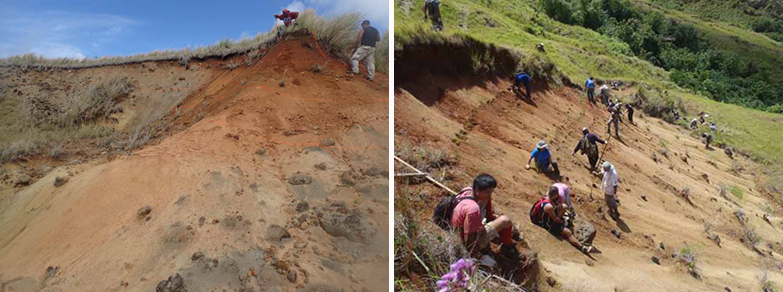- ABOUT US
- PROGRAM AREAS
- CONSERVATION APPROACH
- EDUCATION
- MULTIMEDIA
Restoring Talakhaya Watershed in the Commonwealth of the Northern Mariana Islands
Efforts to restore vegetation on the eroded hillsides of the Talakhaya Watershed in Rota help improve coral condition.
The Talakhaya watershed in Rota, Commonwealth of the Northern Mariana Islands (CNMI), is upland from a vibrant coral reef that is home to many species of reef fish, sea turtles, and other marine life.

The cumulative impacts from uncontrolled burning and deforestation have led to bare, eroded hillsides. As a result, during the rainy season loose soil washes downhill, creating sediment plumes in the water that are visible for miles. Sediment suspended in seawater impacts corals in a number of ways, including drastically reducing the amount of light that reaches the corals and burying the corals in thick layers of fine soil.

The NOAA Coral Reef Conservation Program, CNMI Department of Forestry, and volunteers from the surrounding community are taking action to restore the Talakhaya watershed and reduce the impact of land-based sources of pollution to coral reefs by planting seedlings to stabilize the soil.

Since work began, thousands of outplanted grasses, small trees, and shrubs have taken root, turning the dusty hillsides green once again. These efforts on land are making a big difference in the water, reducing sediment loads to the nearby coral reefs and improving water quality. The result is healthier, more resilient coral reefs.

About Us

The NOAA Coral Reef Conservation Program was established in 2000 by the Coral Reef Conservation Act. Headquartered in Silver Spring, Maryland, the program is part of NOAA's Office for Coastal Management.

The Coral Reef Information System (CoRIS) is the program's information portal that provides access to NOAA coral reef data and products.
Work With US
U.S. Coral Reef Task Force
Funding Opportunities
Employment
Fellowship Program
Contracting Assistance
Graphic Identifier
Featured Stories Archive

Access the archive of featured stories here...
Feedback
Thank you for visiting NOAA’s Coral Reef Conservation Program online. Please take our website satisfaction survey. We welcome your ideas, comments, and feedback. Questions? Email coralreef@noaa.gov.
Stay Connected
Contact Us
NOAA’s Coral Reef Conservation Program
SSMC4, 10th Floor
1305 East West Highway
Silver Spring, MD 20910
coralreef@noaa.gov
